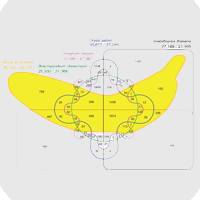Research Focus |
|
香蕉基因组和单子叶植物的进化 2013-01-07 21:07:49 浏览次数:4532 | |
| 香蕉基因组和单子叶植物的进化 来源:仪方生物 www.yeslab.com 香蕉(Musa spp.)包括甜点和烹饪类型,作为姜目类中大型多年生单子叶植物,是研究的比较清楚的禾本目Poales类包括谷物的姊妹种群。香蕉是热带及亚热带国家的粮食安全有着极其重要的意义,并且也是工业化国家最流行的水果。香蕉驯化过程起源于七千年前的东南亚,这个过程中包括多种类和亚种的杂交、人类迁徙的培育、两倍体和三倍无仔的选择、单性结实杂交种后的广泛分布的无性繁殖。目前一半的生产依赖于来源单个三倍体遗传型(Cavendish)的体细胞无性系。害虫和疾病逐步变得更具有适应性,成为了全球香蕉产量的迫在眉睫的危害。研究组绘制了香蕉双单倍体基因型的523兆碱基的序列,为香蕉遗传改良提供了一个重要的基石。研究者在香蕉种系中发现了三个基因组复制,这些发现未见于之前在禾本目Poales种系中和Arecales种系的描述。这个在禾本目Poales之外的首个单子叶植物高连续性基因组序列提供了在植物比较基因组分析中的一个重要桥梁。这个结果表明单子叶植物(commelinidmonocotyledon)系统发育的关系,揭示了禾本科特定特征并促进先于单子叶植物eudicotyledon分化的保守的非编码序列的发现。 The banana (Musa acuminata) genome and the evolution of monocotyledonous plants Bananas (Musa spp.), including dessert and cooking types, are giant perennial monocotyledonous herbs of the order Zingiberales, a sister group to the well-studied Poales, which include cereals. Bananas are vital for food security in many tropical and subtropical countries and the most popular fruit in industrialized countries. The Musa domestication process started some 7,000 years ago in Southeast Asia. It involved hybridizations between diverse species and subspecies, fostered by human migrations, and selection of diploid and triploid seedless, parthenocarpic hybrids thereafter widely dispersed by vegetative propagation. Half of the current production relies on somaclones derived from a single triploid genotype (Cavendish). Pests and diseases have gradually become adapted, representing an imminent danger for global banana production. Here we describe the draft sequence of the 523-megabase genome of aMusa acuminata doubled-haploid genotype, providing a crucial stepping-stone for genetic improvement of banana. We detected three rounds of whole-genome duplications in the Musa lineage, independently of those previously described in the Poales lineage and the one we detected in the Arecales lineage. This first monocotyledon high-continuity whole-genome sequence reported outside Poales represents an essential bridge for comparative genome analysis in plants. As such, it clarifies commelinidmonocotyledon phylogenetic relationships, reveals Poaceaespecific features and has led to the discovery of conserved noncoding sequences predating monocotyledon–eudicotyledon divergence. |
